What are Tarot Card Spreads?
Tarot card spreads are simply different arrangements or patterns in which you lay down tarot cards. Each position in a spread has a particular meaning that adds structure and guidance to the interpretation. Think of each spot as a specific question or theme, and the card that lands there provides the insight.
- Structure and Clarity: Spreads prevent randomness in your reading. Although tarot is highly intuitive, having a designated spot for each card helps you focus on different aspects of your question without feeling lost.
- Depth and Dimension: By breaking down a situation into multiple facets – such as past influences, future potential, obstacles, strengths, or advice – spreads invite you to examine issues from all angles.
Pin it for later! ⤵️
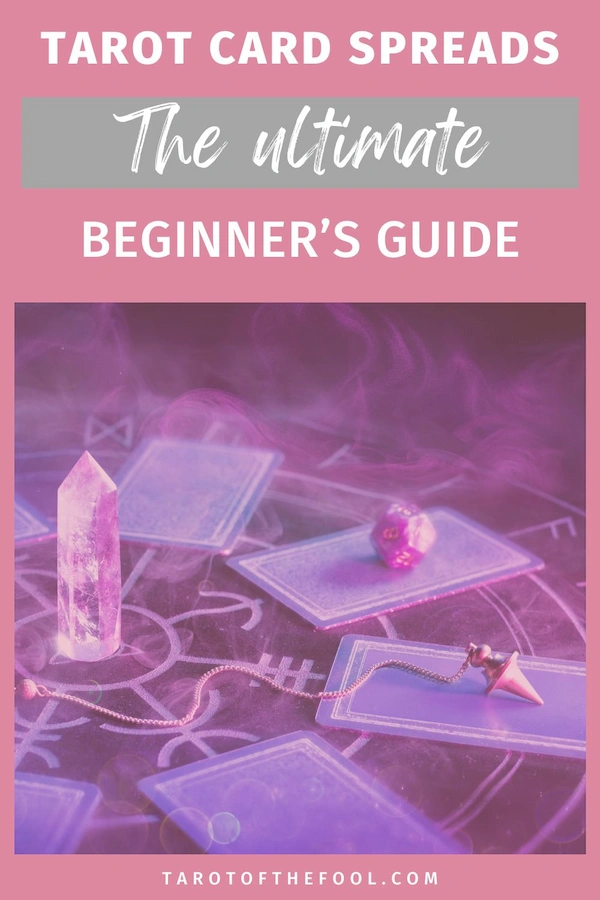
Key Takeaways
- Tarot Spreads Provide Structure and Focus
- Start Simple and Build Confidence
- Customize Spreads to Fit Your Questions
- Popular Spreads to Master
- Tarot is a Blend of Structure and Intuition
- The Journey is Yours to Shape
Why Spreads Matter for Tarot Beginners
As a beginner, using spreads can help you:
Organize Your Thoughts: Different areas of your life or different angles of a problem can be separated into the positions in a spread, so the reading feels less jumbled.
Learn Card Meanings Faster: By assigning a specific context – like the past, present, or advice position – you’ll gain a more concrete sense of how that card’s meaning unfolds in real life.
Build Confidence: When you’re new to tarot, reading multiple cards can feel intimidating. A structured spread breaks down the process into manageable steps.
How to Prepare for a Tarot Reading
Before we dive into the actual spreads, let’s talk about setting the stage. Proper preparation might sound optional, but it can seriously enhance your readings:
Create a Calm Environment: Whether it’s your bedroom, living room, or a quiet corner of your office, choose a place that feels comfortable. Some people like lighting a candle or burning incense, but it’s not mandatory. The main point is to find a spot where you can stay focused.
Clear Your Mind: Take a few deep breaths or meditate briefly. Ask yourself: “What do I want to know?” or “What situation do I need clarity on?”
Shuffle with Intention: As you shuffle, visualize your question. You can even speak it aloud or in your mind to let the cards ‘absorb’ your energy.
Cut the Deck: Some readers cut the deck into three piles and then stack them back up. Do what feels right—tarot is about intuition and personal preference.
Draw the Cards: Depending on your chosen spread, draw the appropriate number of cards from the top of the deck (or from random sections if that resonates more with you).
To get more ideas and tips for beginners on how to bond with your tarot deck, you can read this article.
Now that we’ve covered the basics, let’s jump into the spreads themselves!
Pin it for later! ⤵️
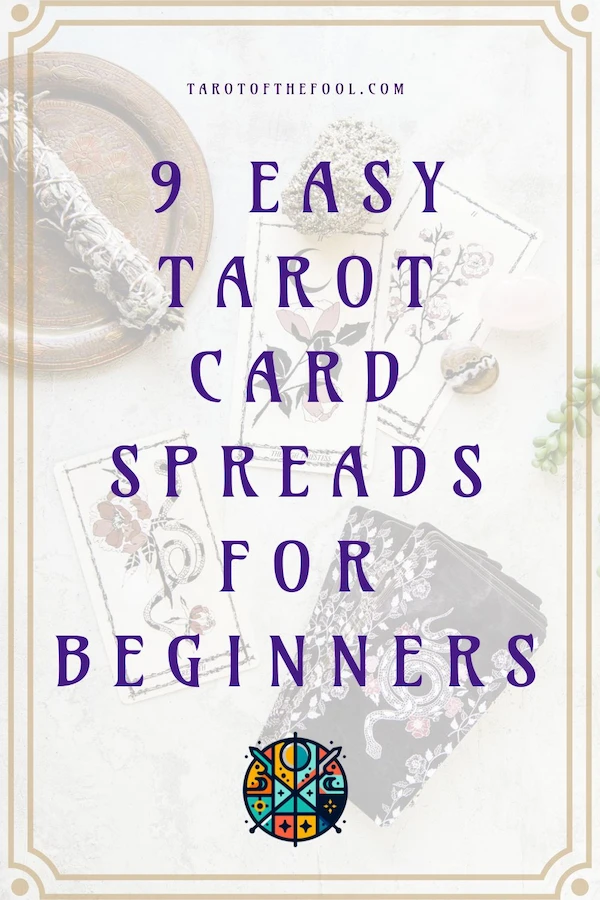
Single-Card Spread
When you’re just starting out – or if you have a super quick question – a single-card spread might be all you need. Despite its simplicity, a single card can be incredibly powerful.
How to Do It
- Shuffle the deck while thinking of a question or situation.
- Draw one card.
- Interpret the card’s meaning in the context of your question.
When to Use It
- Daily Guidance: Pull a card in the morning to see what theme or energy might arise during the day.
- Simple Questions: If you want a straightforward “What energy am I stepping into today?” type of answer.
Tips for Interpretation
- Look at the card’s imagery, symbols, and overall vibe.
- Notice any emotional reaction you have. Do you feel calm, anxious, curious?
- Tie the card’s message to your question – sometimes it’ll resonate immediately, and sometimes you’ll need to reflect on it over time.
Three-Card Spread
Three-card spreads are perhaps the most popular layouts for tarot beginners. They’re still quite manageable while offering more dimensions than a single card.
How to Do It
- Shuffle and focus on your question.
- Draw three cards and place them in a row, left to right.
- Interpret each card according to the chosen theme.
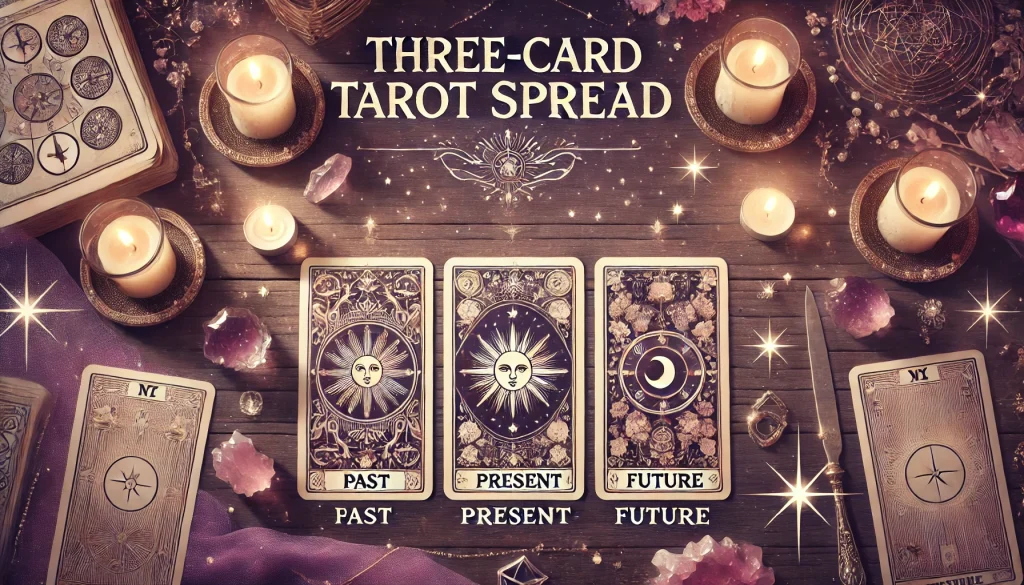
Common Three-Card Variations
- Past, Present, Future:
- Past: Factors or events that have shaped your current situation.
- Present: The energy, feelings, or circumstances you’re dealing with right now.
- Future: Likely outcome if you continue on your current path.
- Situation, Challenge, Advice:
- Situation: What is going on for you at the moment.
- Challenge: Obstacles that might be standing in your way.
- Advice: Guidance or recommended action steps.
- Mind, Body, Spirit:
- Mind: Where your thoughts, beliefs, or mental focus lie.
- Body: Physical state or practical matters in your life.
- Spirit: Emotional well-being or spiritual guidance.
Three-card spreads are perfect for general clarity and short readings. They’re also helpful for self-reflection. If you’re journaling your progress, a three-card spread each week can track how you’re evolving over time.
Five-Card Cross Spread
If you’re looking for a bit more detail than the three-card spread offers, the five-card cross spread is an excellent choice. It retains a compact layout but provides additional layers of insight.
Pin it for later! ⤵️
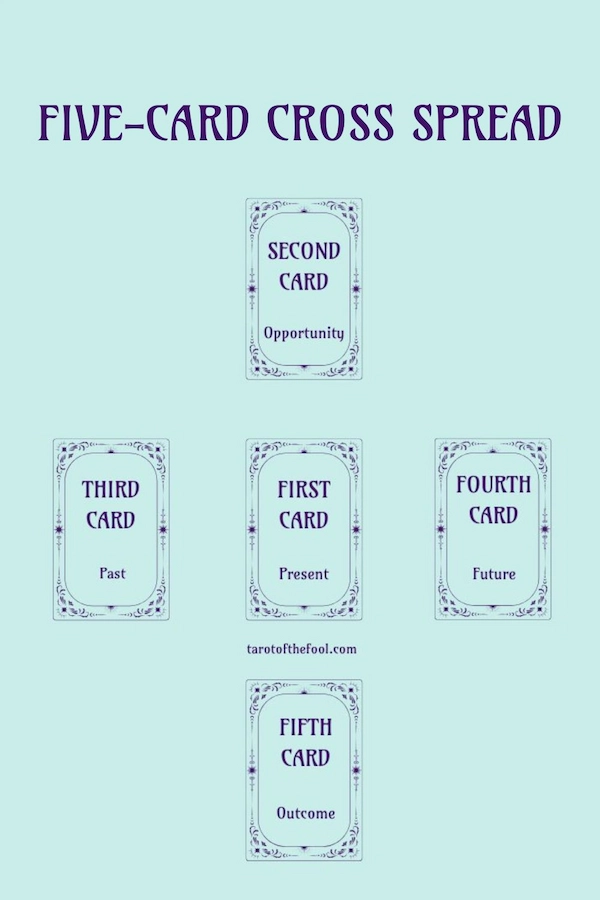
- Center (1): The heart of the matter – your current situation or main focus.
- Top (2): What’s on your mind or a higher-level influence.
- Left (3): Past influences or underlying factors.
- Right (4): Likely direction or immediate future.
- Bottom (5): Advice, outcome, or subconscious influence.
When to Use It
- When you need a little more depth: Perfect for medium-complexity issues, like career choices, relationship questions, or planning next steps in a project.
- Balancing various factors: The cross layout visually shows how different elements interact.
Celtic Cross Spread
The Celtic Cross is often considered the granddaddy of tarot spreads. It offers a panoramic view of a situation, diving into the past, present, subconscious, external influences, and potential outcome.
Pin it for later! ⤵️
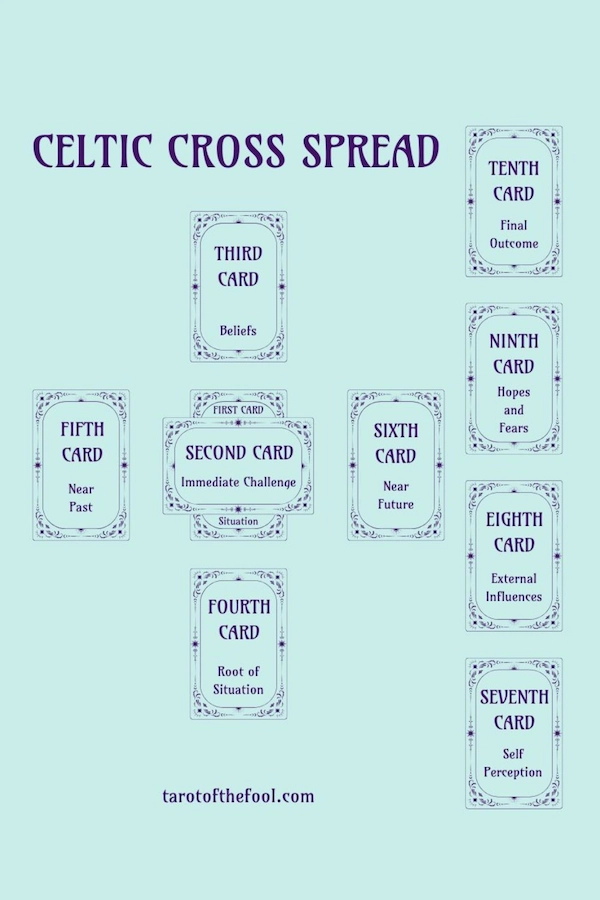
Layout and Positions
- Present Situation: The energy surrounding you right now.
- Immediate Challenge: The main obstacle or issue crossing your path.
- Subconscious Influence / Beliefs / Root Cause: What lies beneath the surface—your deeper motivations or fears.
- Root of Situation / Conscious Goal: What you’re actively working toward or hoping for.
- Recent Past: Events, energies, or influences that recently shaped your situation.
- Near Future: The energy or events soon to unfold.
- Self Perception / Your Attitude: How you feel or perceive the situation.
- External Influences: People, social context, or environmental factors you might not control.
- Hopes and Fears: What you deeply desire or worry about.
- Final Outcome: The likely scenario if everything continues as is.
Tips for Interpretation
- Notice Patterns: Are multiple cards of the same suit appearing? Are there many Major Arcana? Repeated themes suggest strong energies.
- Mind the Positions: The Celtic Cross can be lengthy, so it helps to jot down each card and position in a journal for clarity.
- Be Patient: This spread is hefty. Take your time. You can revisit it over multiple sessions if needed.
Horseshoe Spread
If you’re somewhere between a three-card and a Celtic Cross reading, the Horseshoe Spread might be just right. With seven cards, it offers a good chunk of insight while staying relatively straightforward.
Pin it for later! ⤵️
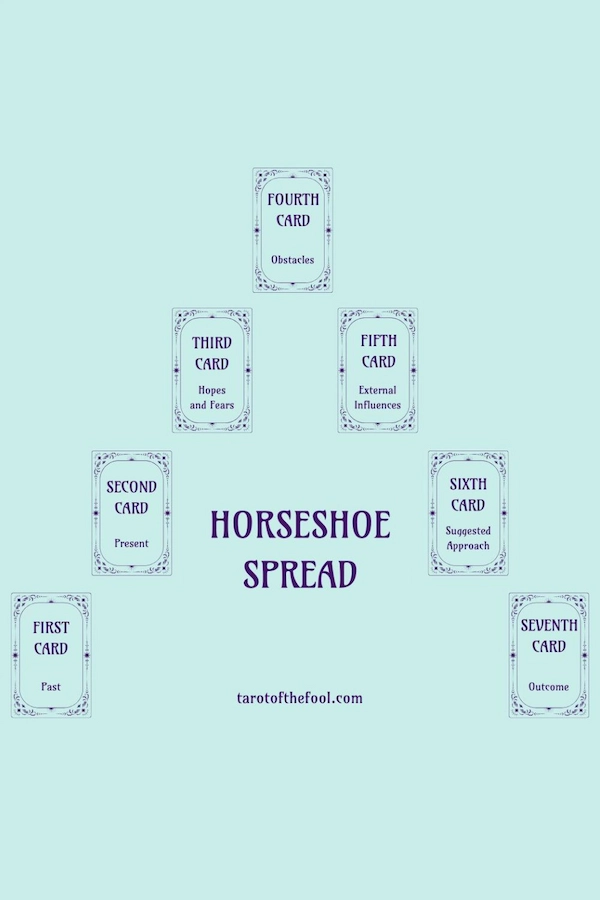
Each position has its own nuance:
- Past
- Present
- Hopes & Fears
- Obstacles
- External Influences
- Suggested Approach
- Outcome
Why Use It?
- Balance of Simplicity and Detail: It doesn’t overwhelm like a 10-card spread but provides more angles than three or five cards.
- Sequential Flow: The Horseshoe layout reads smoothly from past to future, giving a narrative arc to your reading.
Relationship Spread
Sometimes you want to get insights on a partnership, friendship, or any dynamic between two people. A relationship spread places each individual’s perspective front and center, so you can see where you align and where you might clash.
Pin it for later! ⤵️
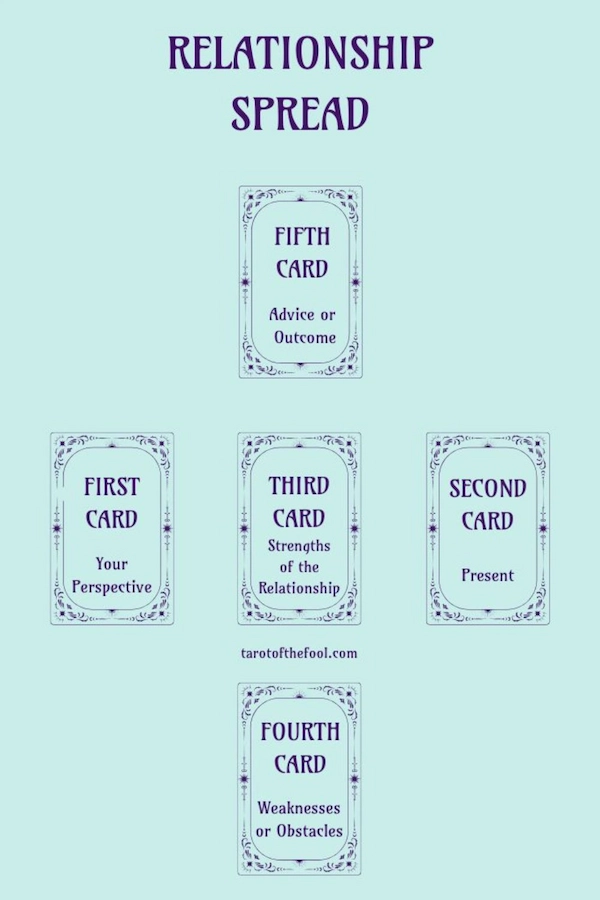
Common Layout (5 Cards)
- Your Perspective – This card is you. Your wants, your needs, your concerns. It encompasses your view of the relationship, and your influence on it.
- Their Perspective – This card is the other person. Their wants, needs, concerns. It represents their view, and their influence.
- Strengths of the Relationship – This card is what uplifts you: what is going right, what is keeping you together. This represents the strengths of the relationship.
- Weaknesses or Obstacles – This card is what pulls you down: what is going wrong, and what is pulling you apart. This represents the issues and weaknesses in the relationship.
- Advice / Outcome – This is the general overview of the relationship: how are you doing on the whole? It may also contain advice for the future. If the querent had a specific concern or issue they wished to focus on, this card will focus on that aspect.
You can also expand this to 7 or 9 cards if you want more detailed aspects like communication style, future potential, emotional blocks, or practical considerations.
Decision-Making Spread
Life is full of crossroads – maybe you’re deciding between two job offers or trying to figure out if you should move to a new city. A decision-making spread can offer clarity when you have more than one path to choose from.
Two-Path Layout (5 Cards):
- Current Situation
- Option A: Pros
- Option A: Cons
- Option B: Pros
- Option B: Cons
- Advice or Likely Outcome (Optional—can be a 6th card in the center or at the end)
You can customize this for three or more options – just duplicate the “pros/cons” positions for each choice.
Seven-Card Chakra Spread
If you’re interested in exploring your energetic well-being or understanding internal blockages, a chakra-based spread is a fantastic tool. The seven main chakras – Root, Sacral, Solar Plexus, Heart, Throat, Third Eye, Crown – each correspond to different life aspects.
Layout and Positions
- Root Chakra (Survival and Grounding)
- Sacral Chakra (Creativity and Emotion)
- Solar Plexus Chakra (Willpower and Confidence)
- Heart Chakra (Love and Compassion)
- Throat Chakra (Expression and Communication)
- Third Eye Chakra (Intuition and Insight)
- Crown Chakra (Spiritual Connection)
Interpretation Tips
- Blockages vs. Strengths: Each card reveals how balanced or unbalanced that specific chakra’s energy might be.
- Action Steps: If a card suggests a blockage, focus on healing modalities (like meditation, journaling, or affirmations) that resonate with that chakra’s energy.
Mandala Spread
For a deeper, more holistic examination of your spiritual journey, the Mandala Spread is a visually stunning and deeply introspective layout. It’s visually appealing and symbolic, designed to provide a comprehensive view of your inner self, spiritual growth, and external influences. Inspired by the sacred geometry of mandalas, this spread combines beauty with insight, offering clarity about your core being and how different areas of your life interact. Picture placing cards in a circular shape, often with one central card representing your core self or present state.
Possible Layout (9 Cards)
- Center Card (Core Self): Represents you at the time of reading – your energy, mindset, or main theme.
- Surrounding Cards: Each card can correspond to areas like relationships, career, personal growth, hidden potential, and so on.
You can label each position in the circle differently depending on what you want to explore – maybe call them “Inner Child,” “Life Purpose,” “Obstacles,” “External Influences,” “Support,” and so forth.
Custom and Creative Spreads
As you grow more comfortable, you’ll likely design your own spreads that cater to your unique questions and goals. Don’t be afraid to experiment! Maybe you’re dealing with stress at work or going through a life transition – create specific positions:
- “What’s the root cause of my stress?”
- “How can I manage it better?”
- “What do I need to learn from this?”
One of the beauties of tarot is its flexibility. Each time you do a custom spread, you’ll refine it further until it becomes your go-to method for certain topics.
Tips for Personalizing Your Tarot Practice
Here are some pointers to help you make these spreads truly your own:
- Journal Your Readings
- Writing down your card draws, impressions, and emotional reactions helps you spot patterns over time.
- A simple format: Date, Question, Spread Layout, Cards Drawn, and Key Insights.
- Use Signifiers
- A signifier is a card you choose to represent yourself or someone you’re reading for. If you feel drawn to a particular Court Card (like the Page of Cups) or Major Arcana (like The Fool), place it in your spread to symbolize the subject.
- Experiment with Reversals
- Some readers use reversed cards (cards that appear upside-down) to signify blocked or opposite energy. If you resonate with that system, incorporate it to add more depth.
- Try Themed Readings
- For example, if you’re focusing on love and relationships, pick a deck that feels gentle or romantic. For shadow work, choose a darker or more introspective deck.
- Combine Tarot with Other Tools
- Some people love mixing oracle cards, runes, or pendulums to cross-check insights. If you’re curious, experiment to see what resonates.
- Practice Regularly
- Consistency is key. The more often you work with your deck, the stronger your intuition and bond with the cards becomes.
Conclusion
In this article, you have a robust manual for exploring various tarot spreads, from the humble single-card draw to the expansive Celtic Cross and everything in between. Each layout serves a unique purpose – so think about your question, time constraints, and how deep you want to dive. Then, pick the spread that suits you best!
You can check out more tarot spreads ideas on this link.
Don’t forget to keep experimenting. Tarot is as much an art as it is a tool for introspection. The best readers combine structure (i.e., spreads) with a healthy dose of intuition and creativity. If one approach doesn’t click for you, try another – there are countless spreads out there, and you can even design your own to match your personal style or current challenges.
By following the guidelines and tips laid out in this post, you’ll gradually hone your tarot reading skills, getting more accurate and meaningful insights each time you shuffle the deck. Embrace the journey, stay curious, and most importantly – have fun. After all, tarot isn’t just about predicting the future; it’s also about understanding yourself on a deeper level.
Feel free to bookmark this guide and revisit it whenever you want. Here’s to your tarot adventures – may every spread bring clarity, growth, and a little bit of magic into your life!
Pin it for later! ⤵️
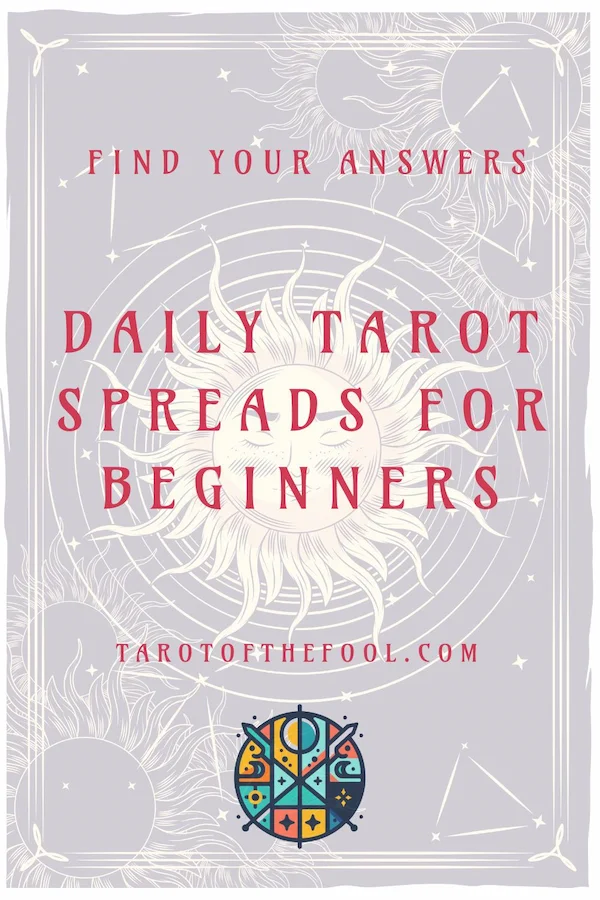

Get Our Tarot Monthly Card Tracker – Free PDF Download
Keep a detailed record of your Tarot readings with our Tarot Monthly Card Tracker, designed to help you spot patterns and deepen your intuition!
Enhance your Tarot practice with this beautifully designed Tarot Monthly Card Tracker! Whether you’re looking to uncover patterns in your readings or deepen your connection with the cards, this tracker makes it easy to document and reflect on your journey.
What Will You Get
✅ Monthly Tarot Card Tracker – Perfect for tracking your daily pulls and spotting recurring themes.
✅ Separate Pages for Major & Minor Arcana – Keep your readings organized with dedicated tracking sheets for both the Major Arcana and Minor Arcana.
✅ Beautiful & Functional Layout – Easy-to-use design for both beginners and experienced readers.
✅ Printable & Digital-Friendly – Print and add to your Tarot Journal, or use digitally with your favorite notetaking app!
Whether you prefer pen and paper or digital annotation, this tracker is your ultimate companion for mindful and intuitive Tarot exploration! 🔮✨


No responses yet